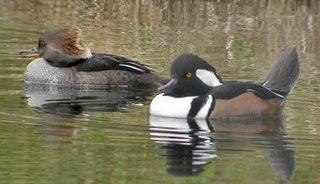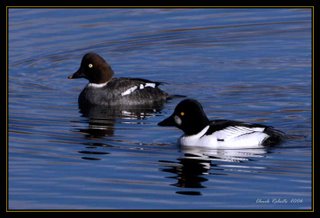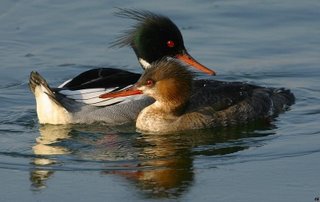My "Big Day" on the lakefront, HA!!!
North of Fullerton between Cannon & Stockton Drives
Belmont Harbor, Chicago, Illinois
Chicago lakefront between Belmont and Addison
Monday, January 16th, Martin Luther King Day, 2006, 10-1130am
I had to take the kids and myself to get flu shots first thing this morning, they were great. Once we got back, I decided it was a nice day for birding and that I would go out to treat myself to a little Jeff time on this federal holiday honoring Mr King.
Where to go? I decided to check out North Pond just north of Chicago's free Lincoln Park Zoo. I had never really looked there carefully even though I have parked right next to it hundreds of times as it is where my running partners often start our Saturday and Sunday runs.
I got there and as I was walking up toward the pond, I heard some Black-capped Chickadees, which would be a new Chicago bird for me. But before I could even think to look for them, I saw a hawk move from one tree to another by the pond. He stayed low down in a large tree near a box that had something to do with the pond's water circulation system so it wouldn't completely freeze over in the winter.
I got within 50 or so feet of him and just began studying him. I had no idea. None. I had never tried to ID a hawk or raptor of any kind ever before, except for a Bald Eagle, and I had no idea where to start. Its back was a lot like a Northern Goshawk juvenile, and it had a faint but distinct lighter stripe above the eye, the eyes were yellowish brown, its beak was yellow with a black tip, the folded wing tips did not reach the end of the banded tail feathers. I watched him, he watched me. I looked in my Sibley's, he looked over the pond. He was faced away from me, so I couldn't see his breast or belly area.
 After 20 minutes of this, which was frankly very exciting for a rookie urban birder, the hawk took flight to go a few trees down. That is when I noticed distinct rufous or redish shoulders, and I decided RED-SHOULDERED HAWK (photo Raul Quinones). A minute or two after landing there, he jumped up and moved high into the sky as he started flying south toward the Lincoln Park Zoo. His undersides were orange and barred as best as I could tell. I may never know if this was a Red-shouldered Hawk, how do you ever really know until you have seen something in the field several times and had it confirmed with or by someone else? But for now, I was counting it as life bird #21, Chicago bird #9. If I learned later that this wasn't what I thought, I would have to painstakingly readjust my records.
After 20 minutes of this, which was frankly very exciting for a rookie urban birder, the hawk took flight to go a few trees down. That is when I noticed distinct rufous or redish shoulders, and I decided RED-SHOULDERED HAWK (photo Raul Quinones). A minute or two after landing there, he jumped up and moved high into the sky as he started flying south toward the Lincoln Park Zoo. His undersides were orange and barred as best as I could tell. I may never know if this was a Red-shouldered Hawk, how do you ever really know until you have seen something in the field several times and had it confirmed with or by someone else? But for now, I was counting it as life bird #21, Chicago bird #9. If I learned later that this wasn't what I thought, I would have to painstakingly readjust my records.After it left, I found my Black-capped Chickadees right away, they became bird
 #10 for Chicago. Then right next to the edge of a pond was a group of Mallard Ducks, but one of the females was a uniform washed out creamy brown color. A hybrid of some sort? Albino? I would learn the coming Sunday from some birders who helped me spot a similar Mallard at North Point Marina, that this was called a leucistic bird, and the condition was known as leucism. It was not rare, but was definitely unusual for Mallard females. I don't know if this is true or not, but I have only been birding for 22 days, and I have now seen two leucistic Mallard females (photo Jeff Skrentny).
#10 for Chicago. Then right next to the edge of a pond was a group of Mallard Ducks, but one of the females was a uniform washed out creamy brown color. A hybrid of some sort? Albino? I would learn the coming Sunday from some birders who helped me spot a similar Mallard at North Point Marina, that this was called a leucistic bird, and the condition was known as leucism. It was not rare, but was definitely unusual for Mallard females. I don't know if this is true or not, but I have only been birding for 22 days, and I have now seen two leucistic Mallard females (photo Jeff Skrentny). Next, I walked to the south end of the pond where there was separate open area of water, and besides a few gulls, Mallards and Canada Geese, there were three ducks hanging out on the far side of the pond. The two had dark heads with white on them, one had his head round with a large white comma on the
 whole back of the head. The second had a flat head with a white swipe going to the back of his head where he had a crest that almost looked like a punk haircut. Both had black backs, brown rufous sides that looked finely barred, and all three had really narrow bills. HOODED MERGANSERS (photo Paul Wiesike), two males, one displaying his crest, and a female; bird #22, #11 for Chicago.
whole back of the head. The second had a flat head with a white swipe going to the back of his head where he had a crest that almost looked like a punk haircut. Both had black backs, brown rufous sides that looked finely barred, and all three had really narrow bills. HOODED MERGANSERS (photo Paul Wiesike), two males, one displaying his crest, and a female; bird #22, #11 for Chicago.There were also Herring and Ring-billed Gulls, as well as three large white domestic Mallard Ducks. At least I think they were Mallards by the company they kept. I needed to warm up, so off to the car I went, three new birds here, off to Belmont to see what I could see there.
Once I got to Belmont, I immediately saw a gray bodied brown headed duck with
 a distinct yellow eye. It was very skittish, but easily enough to identify, a COMMON GOLDENEYE (photo Chuck Roberts). As I walked up the harbor, I also saw several completely different looking ducks with a notable white spot right before the beak below the eye. This, I would learn, was the male Common Goldeneye. Sure they may be common, I would come to learn with more trips into the field, but today they were new for me, birds #23 and Chicago bird #13.
a distinct yellow eye. It was very skittish, but easily enough to identify, a COMMON GOLDENEYE (photo Chuck Roberts). As I walked up the harbor, I also saw several completely different looking ducks with a notable white spot right before the beak below the eye. This, I would learn, was the male Common Goldeneye. Sure they may be common, I would come to learn with more trips into the field, but today they were new for me, birds #23 and Chicago bird #13.It was getting cold for me, and I had to get some hours in on my desk. But
 before I left there was one more new bird. It had a black head with a punk feathered crest, a shockingly thin red bill, a dark breast, black back and gray flank and it was very low in the water. There was a differently colored bird that was similarly shaped, must be the female of these RED-BREASTED MERGANSERS, bird #24 for the year and #14 for Chicago.
before I left there was one more new bird. It had a black head with a punk feathered crest, a shockingly thin red bill, a dark breast, black back and gray flank and it was very low in the water. There was a differently colored bird that was similarly shaped, must be the female of these RED-BREASTED MERGANSERS, bird #24 for the year and #14 for Chicago.I took a quick hike up to see the Mute Swans in the harbor, and on the way I saw a Northern Cardinal, several American Crows, some House Sparrows, Rock Doves, and an unexpected male Downy Woodpecker. It was a good morning of birding, a 17 species day with four new species:
#21 RED-SHOULDERED HAWK
#22 HOODED MERGANSER male & female
#23 COMMON GOLDENEYE male & female
#24 RED-BREASTED MERGANSER male & female

1 Comments:
At 4:34 PM, marcella said…
marcella said…
hi! what are the black ducks with white bills that i keep seeing at the lakefront?? i can't seem to find any information on these.
Post a Comment
<< Home